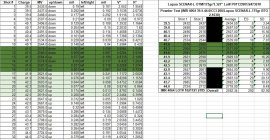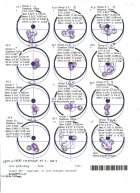Let's assume F-Class.
Chronicle that 25 rounds for me.
OK, this assumes a barrel that is broken in (reasonably).
1. Do some research on this Forum or elsewhere as to what seating depths are working for people with your bullet and barrel combo (e.g. 7mm 180gr Berger Hybrid Target and Krieger 4-groove). Assuming .030" off "first touch" is a good 180gr starting place based on other's experience (for discussion purposes), start there with a typical neck tension (neither minimal nor maximal).
2. Again research the node people are shooting, with your powder (such as Alliant Reloder 16) and your bullet. Then start low and work up in increments of 0.3 grains, all with same seating depth and same neck tension. I might do three-shot groups initially, and even stop after two if one went out.
3. Depending on your gun, start with 2-5 foulers (whatever it seems to need) with the same powder and bullet.
4. Shoot three-shot groups, recording velocity. I normally shoot at 100 yards.*
Always let the barrel cool between groups -- don't rush.
8 three-shot groups is 24 rounds. That would give you a powder range of 0.3 x 8 or 2.4 grains, which should be plenty for a .284 Win or WSM. If, you work with a lesser spread (because you already know the max), then you can repeat groups for more assurance.
5. If nothing works, then experiment further .020" and .040" out etc. However, I think if you do your homework first and see
what amount of jump has worked for others with your bullet, cartridge and barrel type, you may not have to fiddle much.
Shortcut: Find the actual velocity of a top shooter using your cartridge and start close to that. HOWEVER, remember barrels from the same maker can vary by 50 fps or more, and what works for another guy could definitely be TOO HOT in your rifle. Also understand that the other guy may be shooting in a different temp/humidity environment and his speed data could be just plain wrong, or his chrono is 30-40 fps different, or he has a longer barrel and so on. I would say, for a F-classer, I would probably try to start 70-80 fps slower than a known match load.
-------- The "Known node" Shortcut method ----
With my last bench rifle, a 6BRDX with 28" Brux, my load dev was basically done in a dozen rounds, with a 5-shot group to confirm.
After shooting the brass once to blow the shoulders out, I loaded 6 rounds (3x2) in 0.2 gr increments**, seating .007" beyond first touch, looking for a ~2950 fps target velocity. When we looked at the velocity data, I then loaded two more 3-shot groups with the charge that shot around 2954 fps. Both 3-shot groups were in the high ones (for 3). Plenty good enough for me.
That's round count 12 (not counting foulers). We then shot a five-shot group at the same charge to confirm and it was excellent (about a 0.2 flat) with very low ES. I say "we" because my friend Joe Friedrich did the shooting. A rimfire BR Nat'l champ, Joe is a much better trigger-puller than me. The whole process took less than an hour (not counting blowing out the brass previously). I still remember Joe's words after the 5-shot group: "I guess we're done." Yep, I thought. We went back to the loading room, I confirmed the cartridge base to ogive length, and wrote down the powder charge and other details.
Now... if that seating depth had not worked there would be more variables to chase. But I had previously learned that my bullets (Lapua Scenar 105s) liked being in the lands between .005-.010 past "first touch". I also know that those bullets (the old Scenars) were really, really consistent in base to ogive specs.
--------------
* With a known really accurate cartridge (such as 6BR) I might even start off with a few two-shot groups at 50 -- looking for two-in-one hole. Shooting at 50 reduces wind effects by 4X roughly (rule of the square). But, most people will want to shoot at 100.
** When looking for velocity I always have at least two with the same charge, because any one shot can be weird, or not get picked up by your chrono. I work with 0.2 gr here, but with a bigger cartridge such as .284 win, 0.3 might be better.
 Seriously.... I'm looking to improve. Please give me a quick summary of your process. Thx.
Seriously.... I'm looking to improve. Please give me a quick summary of your process. Thx.













